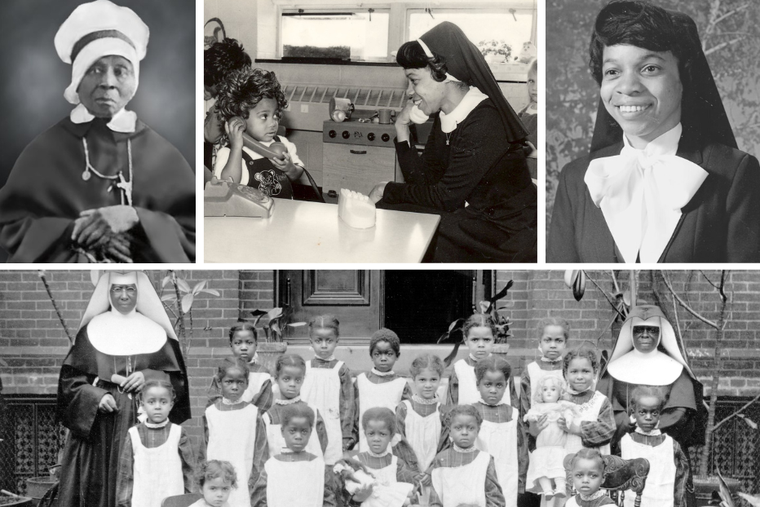Servant of God Mother Mary Lange and the Rich History of Black Catholic Religious Orders
‘EWTN News In Depth’ segment highlights the true story of Mother Mary Elizabeth Lange’s Oblate Sisters of Providence and other orders, showcasing the tremendous impact of African Americans in the Church.

Two centuries ago, Mary Elizabeth Lange (1789-1882) emigrated to the United States from Cuba and joined a friend to offer free education to Baltimore’s Black children. With the support of Baltimore Archbishop James Whitfield, she founded a school for “girls of color” and then the Oblate Sisters of Providence, a religious community for women of African descent. The cause for Mother Mary Lange’s canonization was introduced by Baltimore Cardinal William Keeler in 1991, and as a “Servant of God,” she has begun the first step on the road to canonization.
As many observe Black History Month in February, it is a fitting time for Catholics to consider the accomplishments of Black Catholics in America and the struggles that Catholics such as Mother Mary have had in claiming their place in the Church. A Feb. 24 segment on EWTN News In Depth tells the complex, inspiring story of “The Impact of African Americans in the Church.”
Sister Brenda Cherry entered religious life in 1958 and selected Mother Mary’s Oblates, she said, when the doors of other religious communities were closed to her. She recalled, “I lived right across the street from a group of nuns who were white nuns, and it was unacceptable at that time for me to join them, so I joined the Oblates.”
The Oblate Sisters came into existence more than three decades before the Civil War and its resulting abolition of slavery within the United States. Although Maryland supported the Union, it was a slave state when Mother Mary arrived. EWTN News correspondent Mark Irons noted that she “established St. Frances Academy [in Baltimore] because she believed African American children had the right to an education.”
Shannen Dee Williams of the University of Dayton said that the founding of the Oblate Sisters rejected the mistaken belief that “a woman born into slavery lacked the virtue necessary to enter religious life.”
Williams, the author of the book Subversive Habits, described how “generations of African American Catholic women and girls fought against discrimination and exclusion to answer God’s call for their lives.”
Raised Catholic and today a history professor, Williams said that many people are “unaware of the existence of Black nuns in our Church.”
The number of Black Catholic sisters in the U.S. remains small, just about 1% of the total population, about the same number of Black Catholic priests in the U.S.
Nigerian-born Josephite Father Xavier Edet, who today serves at St. Francis Xavier Church in Baltimore, noted that when he was growing up, the dearth of Black Catholic priests led him to conclude, “Priesthood is for white.” But he longed for that vocation: “I would love to be a priest.”
He eventually discovered African men could be ordained to the priesthood and joined the Josephite Fathers, a community founded in 1871 to serve the nation’s Black Catholics, and is pastor of one of the nation’s oldest predominantly Black Catholic parishes in the U.S. “It’s a loving community. We welcome everybody,” he explained.
Williams wondered how past racial discrimination may have discouraged many lay Black Catholics from pursuing religious vocations. She asked, “Where would we be now if we had had all those vocations? But it certainly is a painful reminder for someone who is still a practicing Catholic, that, for some people, you know race came before faith — when our Catholic tradition teaches us that faith comes before everything else.”
Other Black Catholics with religious vocations were determined to join communities, discrimination or not.
Sister Constance Fenwick of the Oblate Sisters remarked, “They had to accept us because we weren’t going to take any less.”
Oblate Sister Mary Pauline Tamakloe, who was born in Ghana, takes her inspiration from foundress Mother Mary, a woman of determination. When Sister Mary Pauline struggles, she said she follows Mother Mary’s advice to “hasten to the Blessed Sacrament” to lay her challenges before Christ — “and that is where she finds her strength,” as the segment described.
Father Edet added that he hopes the example of communities such as the Josephites and Oblate Sisters will inspire young Black Catholics to consider religious life. He said it is important to “have that connection, to say, ‘If he can do it, I can do it,’ or to look and say, ‘He looks like me; he resembles me.’ It’s not about us anymore. It is about what legacy we are going to leave for the younger ones.”
And that legacy is a blessed one.
“A common theme among these religious sisters in Baltimore is joy,” Irons underscored in the segment.
As Sister Constance put it, “I just can’t tell ya how marvelous it is.”
“Always, God steps in. Providence: That’s where we get the Oblate Sisters of Providence. Providence will provide.”
















